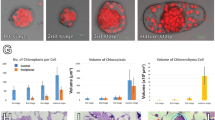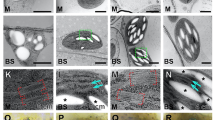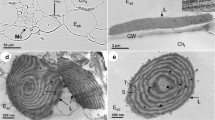Abstract
Bienertia sinuspersici Akhani has an unusual mechanism of C4 photosynthesis which occurs within individual chlorenchyma cells. To perform C4, the mature cells have two cytoplasmic compartments consisting of a central (CCC) and a peripheral (PCC) domain containing dimorphic chloroplasts which are interconnected by cytoplasmic channels. Based on leaf development studies, young chlorenchyma cells have not developed the two cytoplasmic compartments and dimorphic chloroplasts. Fluorescent dyes which are targeted to membranes or to specific organelles were used to follow changes in cell structure and organelle distribution during formation of C4-type chlorenchyma. Chlorenchyma cell development was divided into four stages: 1—the nucleus and chloroplasts occupy much of the cytoplasmic space and only small vacuoles are formed; 2—development of larger vacuoles, formation of a pre-CCC with some scattered chloroplasts; 3—the vacuole expands, cells have directional growth; 4—mature stage, cells have become elongated, with a distinctive CCC and PCC joined by interconnecting cytoplasmic channels. By staining vacuoles with a fluorescent dye and constructing 3D images of chloroplasts, and by microinjecting a fluorescence dye into the vacuole of living cells, it was demonstrated that the mature cell has only one vacuole, which is traversed by cytoplasmic channels connecting the CCC with the PCC. Immunofluorescent studies on isolated chlorenchyma cells treated with cytoskeleton disrupting drugs suspended in different levels of osmoticum showed that both microtubules and actin filaments are important in maintaining the cytoplasmic domains. With prolonged exposure of plants to dim light, the cytoskeleton undergoes changes and there is a dramatic shift of the CCC from the center toward the distal end of the cell.








Similar content being viewed by others
Abbreviations
- BSC:
-
Bundle sheath cell
- CCC:
-
Central cytoplasmic compartment
- CDCFDA:
-
5-(and-6)-carboxy-2′,7′-dichlorofluorescein diacetate
- CFDA:
-
5-(and-6)-carboxyfluorescein diacetate
- CLSM:
-
Confocal laser scanning microscopy
- DiOC6(3):
-
3,3′-Dihexyloxa-carbocyanine iodide
- GB:
-
Glycine betaine
- Lysotracker:
-
LysoTracker® Red DND-99
- MC:
-
Mesophyll cell
- Mitotracker:
-
MitoTracker® Orange CM-H2TMRos
- NAD-ME:
-
NAD malic enzyme
- PCC:
-
Peripheral cytoplasmic compartment
References
Blackman LM, Overall RL (1995) Electric fields affect the orientation of microtubules and cell expansion in pea callus. Protoplasma 189:256–266
Boevink P, Oparka K, Santa-Cruz S, Martin B, Bettridge A, Hawes C (1998) Stacks on tracks: the plant Golgi apparatus traffics on an actin/ER network. Plant J 15:441–447
Chuong SD, Franceschi VR, Edwards GE (2006) The cytoskeleton maintains organelle partitioning required for single-cell C4 photosynthesis in Chenopodiaceae species. Plant Cell 18:2207–2223
Cyr RJ, Palevitz BA (1995) Organization of cortical microtubules in plant cells. Curr Opin Cell Biol 7:65–71
Di Sansebastiano GP, Paris N, Marc-Martin S, Neuhaus JM (2001) Regeneration of a lytic central vacuole and of neutral peripheral vacuoles can be visualized by green fluorescent proteins targeted to either type of vacuoles. Plant Physiol 126:78–86
Edwards GE, Walker D (1983) C3, C4: mechanisms, and cellular and environmental regulation, of photosynthesis. Blackwell, Oxford
Edwards GE, Franceschi VR, Voznesenskaya EV (2004) Single-cell C4 photosynthesis versus the dual-cell (Kranz) paradigm. Annu Rev Plant Biol 55:173–196
Friml J, Benkova E, Mayer U, Palme K, Muster G (2003) Automated whole mount localisation techniques for plant seedlings. Plant J 34:115–124
Furukawa T, Watanabe M, Shihira-Ishiikawa I (1998) Green- and blue-light-mediated chloroplast migration in the centric diatom Pleurosira laevis. Protoplasma 56:495–520
Hatch MD (1987) C4 photosynthesis: a unique blend of modified biochemistry, anatomy and ultrastructure. Biochim Biophys Acta 895:81–106
Himmelspach R, Wymer CL, Lloyd CW, Nick P (1999) Gravity-induced reorientation of cortical microtubules observed in vivo. Plant J 18:449–453
van der Honing HS, Emons AM, Ketelaar T (2007) Actin based processes that could determine the cytoplasmic architecture of plant cells. Biochim Biophys Acta 1773:604–614
Inoue Y, Shibata K (1973) Light-induced chloroplast rearrangements and their action spectra as measured by absorption spectrophotometry. Planta 114:341–358
Inoue Y, Shibata K (1974) Comparative examination of terrestrial plant leaves in terms of light-induced absorption changes due to chloroplast rearrangements. Plant Cell Physiol 15:717–721
Jedd G, Chua NH (2002) Visualization of peroxisomes in living plant cells reveals actomyosin-dependent cytoplasmic streaming and peroxisome budding. Plant Cell Physiol 43:384–392
Kagawa T, Sakai T, Suetsugu N, Oikawa K, Ishiguro S, Kato T, Tabata S, Okada K, Wada M (2001) Arabidopsis NPL1: a phototropin homolog controlling the chloroplast high-light avoidance response. Science 291:2138–2141
Kagawa T, Kasahara M, Abe T, Yoshida S, Wada M (2004) Function analysis of phototropin2 using fern mutants deficient in blue light-induced chloroplast avoidance movement. Plant Cell Physiol 45:416–426
Kandasamy MK, Meagher RB (1999) Actin-organelle interaction: association with chloroplast in Arabidopsis leaf mesophyll cells. Cell Motil Cytoskeleton 44:110–118
Knoblauch M, Van Bel AJ (1998) Sieves tubes in action. Plant Cell 10:35–50
Kost B, Chua NH (2002) The plant cytoskeleton: vacuoles and cell walls make the difference. Cell 108:9–12
Krzeszowiec W, Rajwa B, Dobrucki J, Gabrys H (2007) Actin cytoskeleton in Arabidopsis thaliana under blue and red light. Biol Cell 99:251–260
Lal A, Edwards GE (1996) Analysis of inhibition of photosynthesis under water stress in the C4 species Amaranthus and Zea mays: electron transport, CO2 fixation, and carboxylation capacity. Aust J Plant Physiol 23:403–412
Lara MV, Offermann S, Smith M, Okita TW, Andreo CS, Edwards GE (2008) Leaf development in the single-cell C4 system in Bienertia sinuspersici: expression of genes and peptide levels for C4 metabolism in relation to chlorenchyma structure under different light conditions. Plant Physiol 148:593–610
Mano S, Nakamori C, Hayashi M, Kato A, Kondo M, Nishimura M (2002) Distribution and characterization of peroxisomes in Arabidopsis by visualization with GFP: dynamic morphology and actin-dependent movement. Plant Cell Physiol 43:331–341
Miyake H, Nakamura M (1993) Some factors concerning the centripetal disposition of bundle sheath chloroplasts during the leaf development of Eleusine coracana. Ann Bot 72:205–211
Moriyasu Y, Hattori M, Jauh GY, Rogers JC (2003) Alpha tonoplast intrinsic protein is specifically associated with vacuole membrane involved in an autophagic process. Plant Cell Physiol 44:795–802
Murata T, Kadota A, Wada M (1997) Effects of blue light on cell elongation and microtubule orientation in dark-grown gametophytes of Ceretopteris richardii. Plant Cell Physiol 38:201–209
Nebenführ A, Gallagher LA, Dunahay TG, Frohlick JA, Mazurkiewicz AM, Meehl JB, Staehelin LA (1999) Stop-and-go movements of plant Golgi stacks are mediated by the acto-myosin system. Plant Physiol 121:1127–1141
Newell JM, Leigh RA, Hall JL (1998) Vacuole development in cultured evacuolated oat mesophyll protoplasts. J Exp Bot 49:817–827
Oikawa K, Kasahara M, Kiyosue T, Kagawa T, Suetsugu N, Takahashi F, Kanegae T, Niwa Y, Kadota A, Wada M (2003) Chloroplast unusual positioning1 is essential for proper chloroplast positioning. Plant Cell 15:2805–2815
Prager-Khoutorsky M, Goncharov I, Rabinkov A, Mirelman D, Geiger B, Bershadsky AD (2007) Allicin inhibits cell polarization, migration and division via its direct effect on microtubules. Cell Motil Cytoskeleton 64:321–337
Ruthardt N, Gulde N, Spiegel H, Fischer R, Emans N (2005) Four-dimensional imaging of transvacuolar strand dynamics in tobacco BY-2 cells. Protoplasma 225:205–215
Sakai T, Kagawa T, Kasahara M, Swartz TE, Christie JM, Briggs WR, Wada M, Okada K (2001) Arabidopsis nph1 and npl1: blue light receptors that mediate both phototropism and chloroplast relocation. Proc Natl Acad Sci USA 98:6969–6974
Sakurai N, Domoto K, Takagi S (2005) Blue-light-induced reorganization of the actin cytoskeleton and the avoidance response of chloroplasts in epidermal cells of Vallisneria gigantea. Planta 221:66–74
Shevyakova NI, Paramonova NV, Kuznetsov VV (1998) Proline accumulation in salt resistant tobacco cells as related to the changes in mitochondrial structure. Russ J Plant Physiol 45:736–743
Staehelin LA (1997) The plant ER: a dynamic organelle composed of a large number of discrete functional domains. Plant J 11:1151–1165
Stone BB, Esmon CA, Liscum E (2005) Phototropins, other photoreceptors, and associated signaling: the lead and supporting cast in the control of plant movement responses. Curr Top Dev Biol 66:215–238
Sugimoto K, Williamson RE, Wasteneys GO (2000) New techniques enable comparative analysis of microtubule orientation, wall texture, and growth rate in intact roots of Arabidopsis. Plant Physiol 124:1493–1506
Szechynska-Hebda M, Wedzony M, Dubas E, Kieft H, van Lammeren A (2006) Visualization of microtubules and actin filaments in fixed BY-2 suspension cells using an optimized whole mount immunolabelling protocol. Plant Cell Rep 25:758–766
Takagi S (2003) Actin-based photo-orientation movement of chloroplasts in plant cells. J Exp Biol 206:1963–1969
Taniguchi Y, Taniguchi M, Kawasaki M, Miyake H (2003) Strictness of the centrifugal location of bundle sheath chloroplasts in different NADP-ME C4 grasses. Plant Prod Sci 6:274–280
Van Gestel K, Kohler RH, Verbelen JP (2002) Plant mitochondria move on F-actin, but their positioning in the cortical cytoplasm depends on both F-actin and microtubules. J Exp Bot 53:659–667
Virgin HI (1968) Light and chloroplast movements. Symp Soc Exp Biol 22:329–352
Voznesenskaya EV, Franceschi VR, Kiirats O, Freitag H, Edwards GE (2001) Kranz anatomy is not essential for terrestrial C4 plant photosynthesis. Nature 414:543–546
Voznesenskaya EV, Franceschi VR, Kiirats O, Artyusheva EG, Freitag H, Edwards GE (2002) Proof of C4 photosynthesis without Kranz anatomy in Bienertia cycloptera (Chenopodiaceae). Plant J 31:649–662
Voznesenskaya EV, Koteyeva NK, Chuong SDX, Edwards GE, Akhani H, Franceschi VR (2005) Differentiation of cellular and biochemical features of the single cell C4 syndrome during leaf development in Bienertia cycloptera (Chenopodiaceae). Am J Bot 92:1784–1795
Wada M, Suetsugu N (2004) Plant organelle positioning. Curr Opin Plant Biol 7:626–631
Wasteneys GO, Yang Z (2004) New views on the plant cytoskeleton. Plant Physiol 136:3884–3891
Acknowledgments
This material is based upon work supported by the National Science Foundation under Grants IBN-0236959 and IBN-0641232. We thank the Franceschi Microscopy and Imaging Center of Washington State University for use of facilities and for staff assistance, and C. Cody for plant growth management.
Author information
Authors and Affiliations
Corresponding author
Rights and permissions
About this article
Cite this article
Park, J., Knoblauch, M., Okita, T.W. et al. Structural changes in the vacuole and cytoskeleton are key to development of the two cytoplasmic domains supporting single-cell C4 photosynthesis in Bienertia sinuspersici . Planta 229, 369–382 (2009). https://doi.org/10.1007/s00425-008-0836-8
Received:
Accepted:
Published:
Issue Date:
DOI: https://doi.org/10.1007/s00425-008-0836-8




